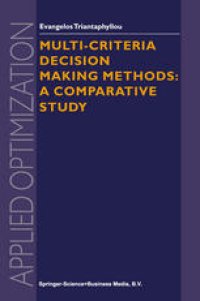
Ebook: Multi-criteria Decision Making Methods: A Comparative Study
Author: Evangelos Triantaphyllou (auth.)
- Tags: Operation Research/Decision Theory, Operations Research Management Science, Artificial Intelligence (incl. Robotics), Mathematical Logic and Foundations
- Series: Applied Optimization 44
- Year: 2000
- Publisher: Springer US
- Edition: 1
- Language: English
- pdf
Multi-Criteria Decision Making (MCDM) has been one of the fastest growing problem areas in many disciplines. The central problem is how to evaluate a set of alternatives in terms of a number of criteria. Although this problem is very relevant in practice, there are few methods available and their quality is hard to determine. Thus, the question `Which is the best method for a given problem?' has become one of the most important and challenging ones.
This is exactly what this book has as its focus and why it is important. The author extensively compares, both theoretically and empirically, real-life MCDM issues and makes the reader aware of quite a number of surprising `abnormalities' with some of these methods. What makes this book so valuable and different is that even though the analyses are rigorous, the results can be understood even by the non-specialist.
Audience: Researchers, practitioners, and students; it can be used as a textbook for senior undergraduate or graduate courses in business and engineering.
Multi-Criteria Decision Making (MCDM) has been one of the fastest growing problem areas in many disciplines. The central problem is how to evaluate a set of alternatives in terms of a number of criteria. Although this problem is very relevant in practice, there are few methods available and their quality is hard to determine. Thus, the question `Which is the best method for a given problem?' has become one of the most important and challenging ones.
This is exactly what this book has as its focus and why it is important. The author extensively compares, both theoretically and empirically, real-life MCDM issues and makes the reader aware of quite a number of surprising `abnormalities' with some of these methods. What makes this book so valuable and different is that even though the analyses are rigorous, the results can be understood even by the non-specialist.
Audience: Researchers, practitioners, and students; it can be used as a textbook for senior undergraduate or graduate courses in business and engineering.
Multi-Criteria Decision Making (MCDM) has been one of the fastest growing problem areas in many disciplines. The central problem is how to evaluate a set of alternatives in terms of a number of criteria. Although this problem is very relevant in practice, there are few methods available and their quality is hard to determine. Thus, the question `Which is the best method for a given problem?' has become one of the most important and challenging ones.
This is exactly what this book has as its focus and why it is important. The author extensively compares, both theoretically and empirically, real-life MCDM issues and makes the reader aware of quite a number of surprising `abnormalities' with some of these methods. What makes this book so valuable and different is that even though the analyses are rigorous, the results can be understood even by the non-specialist.
Audience: Researchers, practitioners, and students; it can be used as a textbook for senior undergraduate or graduate courses in business and engineering.
Content:
Front Matter....Pages i-xxix
Introduction to Multi-Criteria Decision Making....Pages 1-4
Multi-Criteria Decision Making Methods....Pages 5-21
Quantification of Qualitative Data for MCDM Problems....Pages 23-55
Deriving Relative Weights from Ratio Comparisons....Pages 57-72
Deriving Relative Weights from Difference Comparisons....Pages 73-86
A Decomposition Approach for Evaluating Relative Weights Derived from Comparisons....Pages 87-113
Reduction of Pairwise Comparisons Via a Duality Approach....Pages 115-129
A Sensitivity Analysis Approach for MCDM Methods....Pages 131-175
Evaluation of Methods for Processing a Decision Matrix and Some Cases of Ranking Abnormalities....Pages 177-199
A Computational Evaluation of the Original and the Revised AHP....Pages 201-212
More Cases of Ranking Abnormalities when some MCDM Methods are used....Pages 213-233
Fuzzy Sets and Their Operations....Pages 235-239
Fuzzy Multi-Criteria Decision Making....Pages 241-262
Conclusions and Discussion for Future Research....Pages 263-265
Back Matter....Pages 267-289
Multi-Criteria Decision Making (MCDM) has been one of the fastest growing problem areas in many disciplines. The central problem is how to evaluate a set of alternatives in terms of a number of criteria. Although this problem is very relevant in practice, there are few methods available and their quality is hard to determine. Thus, the question `Which is the best method for a given problem?' has become one of the most important and challenging ones.
This is exactly what this book has as its focus and why it is important. The author extensively compares, both theoretically and empirically, real-life MCDM issues and makes the reader aware of quite a number of surprising `abnormalities' with some of these methods. What makes this book so valuable and different is that even though the analyses are rigorous, the results can be understood even by the non-specialist.
Audience: Researchers, practitioners, and students; it can be used as a textbook for senior undergraduate or graduate courses in business and engineering.
Content:
Front Matter....Pages i-xxix
Introduction to Multi-Criteria Decision Making....Pages 1-4
Multi-Criteria Decision Making Methods....Pages 5-21
Quantification of Qualitative Data for MCDM Problems....Pages 23-55
Deriving Relative Weights from Ratio Comparisons....Pages 57-72
Deriving Relative Weights from Difference Comparisons....Pages 73-86
A Decomposition Approach for Evaluating Relative Weights Derived from Comparisons....Pages 87-113
Reduction of Pairwise Comparisons Via a Duality Approach....Pages 115-129
A Sensitivity Analysis Approach for MCDM Methods....Pages 131-175
Evaluation of Methods for Processing a Decision Matrix and Some Cases of Ranking Abnormalities....Pages 177-199
A Computational Evaluation of the Original and the Revised AHP....Pages 201-212
More Cases of Ranking Abnormalities when some MCDM Methods are used....Pages 213-233
Fuzzy Sets and Their Operations....Pages 235-239
Fuzzy Multi-Criteria Decision Making....Pages 241-262
Conclusions and Discussion for Future Research....Pages 263-265
Back Matter....Pages 267-289
....